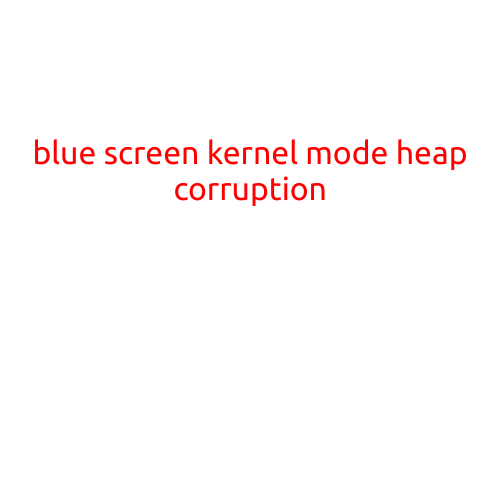
Blue Screen of Death: “Kernel Mode Heap Corruption” Error
The Blue Screen of Death (BSOD) is a notoriously frustrating error that can strike at any moment, leaving users powerless and bewildered. One of the most common causes of a BSOD is “Kernel Mode Heap Corruption,” a complex error that can be challenging to troubleshoot. In this article, we’ll delve into the world of kernel-mode memory management, explaining what causes this error, how to diagnose it, and most importantly, how to fix it.
What is Kernel Mode Heap Corruption?
In computer science, a heap is a data structure used to manage memory allocation. The kernel, the core operating system, uses a heap to manage the memory allocated to running programs. When a program requests memory from the operating system, the kernel allocates a block of memory from the heap. In kernel mode, the operating system executes with elevated privileges, allowing it to directly access and manage memory.
Kernel mode heap corruption occurs when the kernel’s memory management code fails, causing the heap to become corrupted. This corruption can lead to a BSOD, as the kernel’s internal state becomes inconsistent, making it impossible for the operating system to continue executing.
Causes of Kernel Mode Heap Corruption
There are several reasons why kernel mode heap corruption might occur. Some common causes include:
- Driver issues: Malfunctioning or outdated device drivers can cause kernel mode heap corruption by corrupting the memory management code.
- Hardware issues: Faulty or malfunctioning hardware, such as RAM or storage devices, can cause data corruption, leading to kernel mode heap errors.
- Malware infections: Malware, such as viruses or trojans, can inject malicious code into the kernel, causing heap corruption.
- System file corruption: Corrupted system files or registry entries can cause the kernel to malfunction, leading to heap corruption.
- Overheating: High temperatures can cause hardware components to malfunction, leading to kernel mode heap errors.
Symptoms of Kernel Mode Heap Corruption
The symptoms of kernel mode heap corruption are straightforward: a BSOD with a cryptic error message. The error message will typically look like this:
IRQL_NOT_LESS_OR_EQUAL
**ntfs.sys+… (Address)`
This error indicates that a kernel-mode driver attempted to write to memory that is marked as read-only (RO).
Diagnosing Kernel Mode Heap Corruption
To diagnose kernel mode heap corruption, you’ll need to collect information about the error and analyze the system’s configuration. Here are some steps to help you get started:
- Collect the BSOD information: When the BSOD appears, press the F8 key to open the “Advanced Boot Options” menu. Select “Disable automatic restart on system failure” to let the BSOD display the error message. Note down the error message and the hexadecimal address.
- Analyzing the error message: Use an online BSOD decoder tool, such as BlueScreenView or WhoCrashed, to analyze the error message. This will help you identify the culprit driver or component responsible for the error.
- Checking system logs: Review the system event logs in Event Viewer to see if any errors or warnings occurred around the time of the BSOD.
- Running system file checks: Use the built-in System File Checker (SFC) tool to scan and repair corrupted system files.
Fixing Kernel Mode Heap Corruption
Once you’ve diagnosed the issue, you can start fixing it. Here are some steps to help you resolve kernel mode heap corruption:
- Update drivers: Update outdated or malfunctioning drivers to the latest version.
- Disable overclocking: Disable overclocking settings on your CPU or RAM to prevent overheating.
- Run a virus scan: Run a full virus scan with your antivirus software to detect and remove malware.
- Perform a system file scan: Use the SFC tool to scan and repair corrupted system files.
- Reset Windows: If none of the above steps work, you may need to perform a System Restore or a clean install of Windows.
Conclusion
Kernel mode heap corruption is a complex error that requires careful diagnosis and troubleshooting. By understanding the causes and symptoms of this error, you can take steps to prevent it from occurring in the future. Remember to update your drivers, run system file checks, and perform regular virus scans to keep your system stable and running smoothly.





